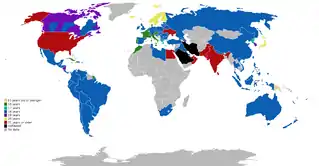Alcoholism in adolescence
Alcohol is a liquid form substance which contains ethyl alcohol (also known formally as ethanol) that can cause harm and even damage to a persons DNA.[1] "Alcohol consumption is recognized worldwide as a leading risk factor for disease, disability, and death" and is rated as the most used and abused substance by adolescences. Adolescence is a transitional stage of physical and psychological changes, usually a time in a person life in which they go through puberty.[2] Combining these transitional stages and the intake of alcohol can leave a number of consequences for an adolescent.[3]
Consequences of alcoholism throughout Adolescence

Most research is based on alcohol and the effects on people in general, essentially relating to adults. Little to no research is shown on the intake of alcohol throughout adolescents and the consequences that binge drinking from a young age can create. "The rate of alcohol use increases sharply between the ages of 12 and 21 years, and adolescents frequently adopt a binge-like drinking pattern".[4] These patterns can then lead to various consequences including automobile accidents, drug abuse, sexual activity, skipping school and failing grades.[5] "Recent studies show that alcohol consumption has the potential to trigger long-term biological changes that may have detrimental effects on the developing adolescent brain, including neurocognitive impairment."[4]
Under age drinking is a danger that brings many dangers and risks for all. Underage drinking causes 5,000 deaths a year. 1,900 by motor vehicle, 1,600 involving homicides, 300 suicides.[6]
Reason for Occurrence
Marquis states how "Adolescent alcohol use is not an acceptable rite of passage but a serious threat to adolescent development and health, as the statistics related to adolescent impairment, injury, and death attest."[4] Research shows how an adolescent makes the decision to consume alcohol because they are influenced by various factors. "These factors include normal maturational changes that all adolescents experience; genetic, psychological and social factors specific to each adolescent and the various social and cultural environments that surround adolescent, including their families, schools and communities".[4] It is also shown that early onset of alcohol intake can lead to high levels of alcohol use in adulthood.[4] Alcoholism throughout adolescents is increasing yearly for a number of different reasons. These reasons include:
- Availability of alcohol
- Peer pressure
- Role model
- Television
- Anxiety or stress [7]
Prevention
There are a number of ways to preventing alcoholism throughout adolescents. One of the main ways to do this is to "Promote an understanding of underage alcohol consumption in the context of human development and maturation that takes into account individual adolescent characteristics as well as environmental, ethic, cultural and gender differences".[8] Another way in preventing underage drinking would be by reducing the cultural forces which are encouraging and supporting underage drinking will also contribute to preventing adolescents from consuming alcohol as a culture in which adolescents feel that it is acceptable, will allow them to think that it is appropriate. Another important component to preventing alcoholism throughout adolescence is the responsibility of the government, to send a message to underage drinkers informing them how themselves and the rest of society strongly disapprove underage alcohol use because of the severe consequences it can cause and also informing that it will not be tolerated.[8]
Minimum legal drinking age

A minimum legal drinking age for the buying or consuming of alcohol is in place in many of the world's countries, typically with the intent to protect the young from alcohol-related harm.[9] This age varies between countries; for example, the minimum legal drinking age for Australia is 18, whereas the MLDA in the United States is 21.[9]
See also
References
- Tomberg, C. (2010). Categories of alcohol consumers: Definitions and criteria of alcohol addiction. Journal of Psychophysiology, 24(4), 213-214. doi:10.1027/0269-8803/a000034
- Schindler, A. G., Tsutsui, K. T. and Clark, J. J. (2014), Chronic Alcohol Intake During Adolescence, but not Adulthood, Promotes Persistent Deficits in Risk-Based Decision Making. Alcoholism: Clinical and Experimental Research, 38: 1622–1629. doi:10.1111/acer.12404
- White, Helene Raskin; Jackson, Kristina (2004). "Social and Psychological Influences on Emerging Adult Drinking Behavior". Alcohol Research & Health. 28 (4): 182–190. ISSN 1535-7414. PMC 6601679.
- Foltran, F., Gregori, D., Franchin, L., Verduci, E., & Giovannini, M. (2011). Effect of alcohol consumption in prenatal life, childhood, and adolescence on child development. Nutrition Reviews, 69(11), 642-659.
- DiClemente, R. J., Santelli, J. S., & Crosby, R. A. (Eds.). (2009). Adolescent Health : Understanding and Preventing Risk Behaviors. Hoboken, NJ, USA: Jossey-Bass. Retrieved from http://www.ebrary.com.ipacez.nd.edu.au
- "Consequences of Underage Drinking". Johns Hopkins. Retrieved April 20, 2016.
- K. S. Kendler, C. Gardner and D. M. Dick (2011). Predicting alcohol consumption in adolescence from alcohol-specific and general externalizing genetic risk factors, key environmental exposures and their interaction. Psychological Medicine, 41, pp 1507-1516. doi:10.1017/S003329171000190X.
- Marquis, N. P. (2009). Substance Abuse Assessment, Interventions and Treatment : Preventing and Reducing Underage Drinking. New York, NY, USA: Nova. Retrieved from http://www.ebrary.com.ipacez.nd.edu.auhttps://ipacez.nd.edu.au/login?url=http://site.ebrary.com/lib/notredameaustralia/reader.action?docID=10661785&ppg=3
- Callaghan, R. C., Sanches, M. and Gatley, J. M. (2013), Impacts of the minimum legal drinking age legislation on in-patient morbidity in Canada, 1997–2007: a regression-discontinuity approach. Addiction, 108: 1590–1600. doi:10.1111/add.12201